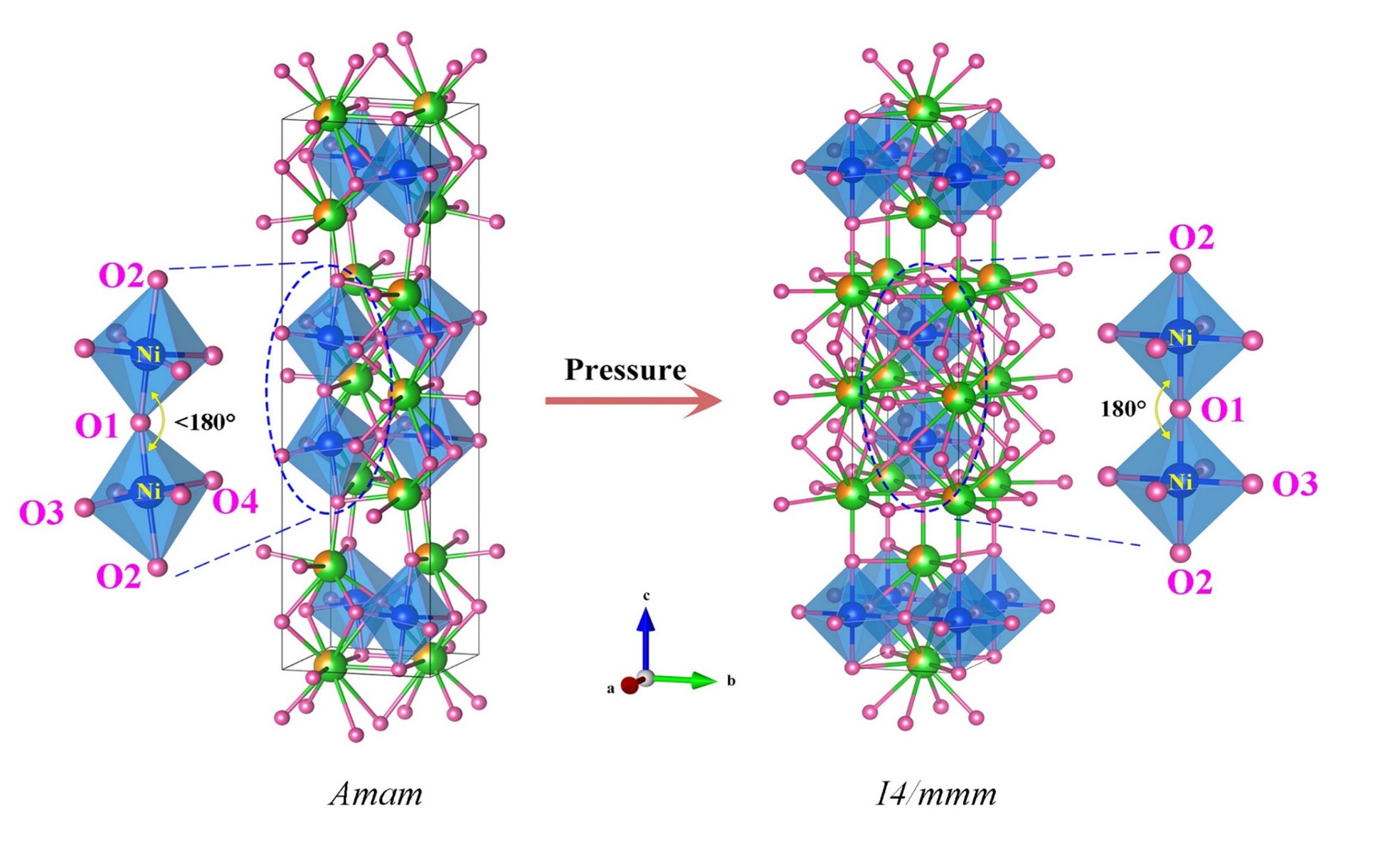Pathways to Achieve Ambient Pressure High-Temperature Superconductivity in Nickelates
The Promise and Challenge of Nickelates
Nickelates have emerged as a promising family of superconductors due to their structural and electronic similarities to copper oxides, which dominate the field of high-temperature superconductivity. However, achieving superconductivity in nickelates has proven more elusive. In particular, La₃Ni₂O₇, a bilayer nickelate compound, requires extreme pressures exceeding 14 GPa to transition into a superconducting state. This transition is accompanied by a structural change from an orthorhombic to a tetragonal crystal symmetry, which is considered essential for superconducting behavior.
The challenge lies in replicating this high-pressure-induced structural transition under ambient conditions, which would make these materials more feasible for widespread technological applications. Recent research provides new insights into how chemical and physical pressure can be manipulated to achieve this goal, as well as innovative strategies to stabilize the required tetragonal phase at ambient pressure.

Crystal structure transformation of La3-xRxNi2O7-δ under high pressure
Key Findings
A team of researchers conducted a series of experiments and theoretical calculations to unravel the roles of chemical and physical pressures in influencing the structural properties of La₃Ni₂O₇. Their findings highlight the complex interplay of factors governing the material’s behavior and point toward a potential path for stabilizing its superconducting state at ambient pressure.
- Chemical Pressure Effects
The researchers explored the substitution of lanthanum (La) with smaller rare-earth elements such as praseodymium (Pr), neodymium (Nd), terbium (Tb), and yttrium (Y). These substitutions introduced chemical pressure by reducing the average ionic radius of the A-site cations, effectively shrinking the lattice dimensions of the material.
However, rather than facilitating the transition to a tetragonal structure, this chemical pressure increased the orthorhombic distortion of the crystal lattice. This distortion raised the critical pressure (Pc) required for the structural transition, as confirmed by high-pressure synchrotron X-ray diffraction (HP-SXRD) experiments. The results revealed a counterintuitive relationship: while chemical pressure reduced the lattice dimensions anisotropically, it inhibited the desired symmetry transition necessary for superconductivity.
- Physical Pressure Effects
In contrast, applying physical pressure uniformly compressed the lattice and progressively straightened the Ni-O-Ni bond angle toward 180°. This structural adjustment was critical for driving the orthorhombic-to-tetragonal transition. Density functional theory (DFT) calculations corroborated these experimental observations, emphasizing that physical pressure acts as a more direct and effective mechanism for enabling the structural transformation required for superconductivity.
- A Novel Strategy: Leveraging Larger Cations
To overcome the limitations of chemical pressure, the researchers proposed an innovative approach. By increasing the average ionic radius (<rA>) of A-site cations, the critical pressure for the structural transition could be reduced to ambient levels. Larger alkaline earth cations such as strontium (Sr²⁺) or barium (Ba²⁺) were identified as promising candidates to replace lanthanum.
This substitution not only stabilizes the tetragonal phase at ambient pressure but also introduces additional charge carriers, potentially enhancing the superconducting properties of the material. The team estimated that an average ionic radius of approximately 1.232 Å would be sufficient to achieve ambient pressure stability, paving the way for practical applications.

Broader Implications
The findings challenge traditional assumptions about the role of chemical pressure in driving structural transitions in nickelates. While smaller rare-earth elements have been widely used to apply chemical pressure in other materials, this study demonstrates that such substitutions can be counterproductive in La₃Ni₂O₇. Instead, the proposed strategy of using larger cations offers a more viable route to ambient pressure high-temperature superconductivity.
This research has broader implications for the design and optimization of nickelate superconductors. It highlights the need for a nuanced understanding of how lattice distortions, bond angles, and ionic radii influence structural and electronic properties. Furthermore, the insights gained from this study could inform the development of other superconducting materials that rely on similar mechanisms.
Challenges and Future Directions
Despite these promising results, several challenges remain. Synthesizing high-purity samples with sufficient levels of substitution for larger cations is a technically demanding process. Additionally, theoretical models also need to be refined to account for the complex interplay between structural, electronic, and magnetic factors in these materials. Future research will focus on experimental validation of the proposed strategies and exploring the potential for further enhancements in superconducting performance.
Conclusion
The quest for high-temperature superconductivity at ambient pressure remains one of the most exciting frontiers in materials science. This study represents a significant step forward, offering new insights into the mechanisms underlying structural transitions in nickelates and proposing innovative strategies for material design.
By stabilizing the tetragonal phase of La₃Ni₂O₇ at ambient pressure through the use of larger cations, researchers have opened a new pathway toward practical applications of nickelate superconductors. While challenges persist, the findings underscore the potential of nickelates to become a cornerstone of next-generation superconducting technologies.
This breakthrough not only advances our understanding of high-temperature superconductivity but also lays the groundwork for future discoveries that could reshape the landscape of modern technology.
Follow the Topic
-
npj Quantum Materials

An open access journal that publishes works that significantly advance the understanding of quantum materials, including their fundamental properties, fabrication and applications.
Related Collections
With Collections, you can get published faster and increase your visibility.
Intertwined Orders in Quantum Materials – In Memory of Daniel Khomskii
Publishing Model: Open Access
Deadline: May 13, 2026
Altermagnetic Materials and Phenomena
Publishing Model: Open Access
Deadline: Apr 30, 2026


Please sign in or register for FREE
If you are a registered user on Research Communities by Springer Nature, please sign in